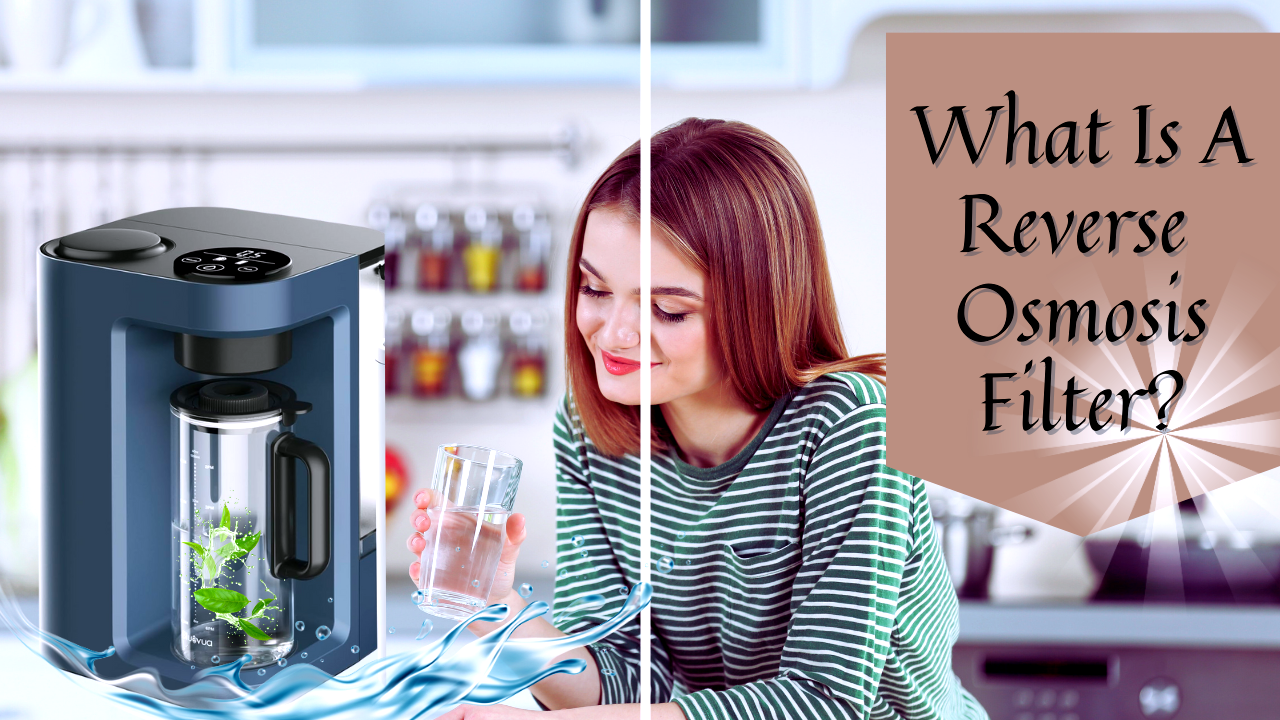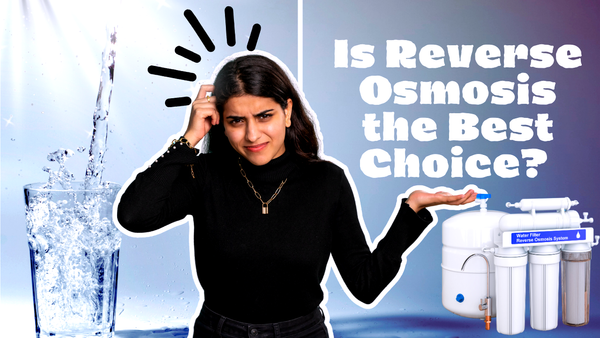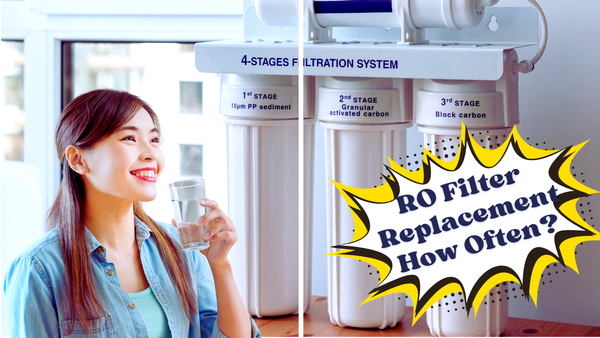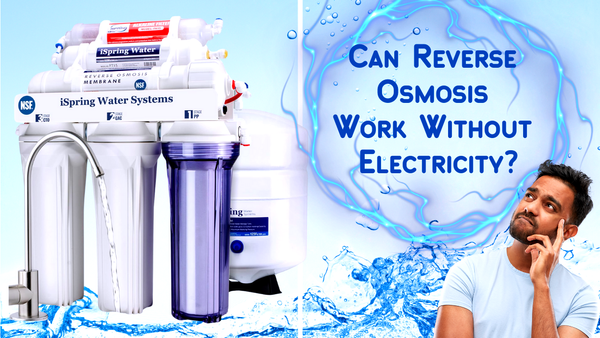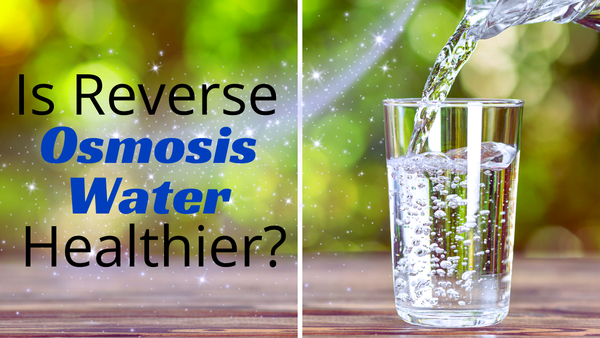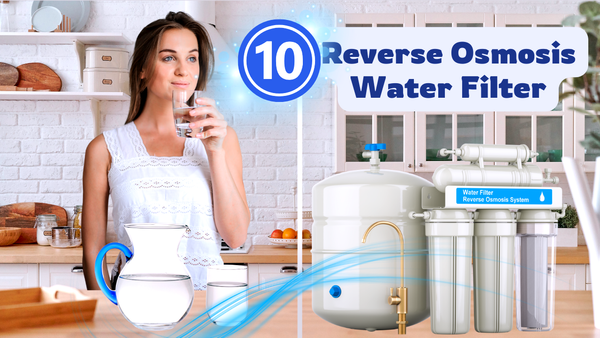Key Takeaways:
- Reverse osmosis water filters provide high-quality drinking water by removing contaminants through a semi-permeable membrane.
- These systems effectively eliminate volatile organic compounds, heavy metals, and dissolved salts from tap water.
- Reverse osmosis systems are versatile and suitable for both point-of-use and whole-house applications.
Introduction to Reverse Osmosis Water Filters
Reverse osmosis water filters have become popular for households seeking pure and safe drinking water. These systems use a semi-permeable membrane to remove contaminants, ensuring that the water you consume is free from harmful substances. But what exactly is a reverse osmosis filter, and how does it work? A reverse osmosis filtration system typically includes multiple stages of filtration, such as sediment filters, carbon filters, and the RO membrane, which work together to reduce contaminants and improve water quality effectively.
In this article, we will delve into the intricacies of reverse osmosis systems, exploring their components, benefits, and applications. By the end, you’ll have a comprehensive understanding of why these systems are considered one of the best solutions for water filtration.

The Basics of Reverse Osmosis
Reverse osmosis (RO) is a water purification process that uses a semi-permeable membrane to remove ions, molecules, and larger particles from drinking water. The process, known as reverse osmosis water filtration, works by applying pressure to overcome osmotic pressure, a colligative property driven by chemical potential differences of the solvent.
In simpler terms, reverse osmosis forces water through a membrane that filters out contaminants, leaving you with clean, fresh water. This method is highly effective in removing a wide range of impurities, including volatile organic compounds (VOCs), heavy metals, and dissolved salts.
Components of a Reverse Osmosis System
A typical reverse osmosis system consists of several key components, each playing a crucial role in the filtration process. These include the pre-filters, the reverse osmosis membrane, the post-filters, and the storage tank.
Pre-filters are designed to remove larger particles and sediments from the water before they reach the RO membrane. This helps to protect the membrane and extend its lifespan. The reverse osmosis membrane is the heart of the system, where the actual filtration takes place. Post-filters further polish the water, removing any remaining impurities before it reaches your tap.
How Reverse Osmosis Works
Osmosis filtration systems, including reverse osmosis (RO), use a semi-permeable membrane to filter out impurities from tap water. When water is pushed through this membrane, it leaves behind contaminants like volatile organic compounds (VOCs), heavy metals, and dissolved salts. The result is pure, filtered water that is safe to drink.
Components of a Reverse Osmosis System

- Pre-Filters: Remove larger particles and protect the RO membrane.
- Reverse Osmosis Membrane: The heart of the system, where most contaminants are filtered out.
- Post-Filters: Ensure any remaining impurities are removed, improving taste and smell.
- Storage Tank: Holds the clean water until you need it.
Benefits of Reverse Osmosis
One of the primary benefits of reverse osmosis is its ability to remove a wide range of contaminants from water. This includes not only volatile organic compounds and heavy metals but also dissolved salts and other harmful substances. As a result, reverse osmosis systems provide high-quality drinking water that is safe and healthy. Reverse osmosis filtration systems are highly effective in reducing impurities, but they require regular maintenance to ensure optimal performance.
Another advantage of reverse osmosis is its versatility. These systems can be used in various applications, from point-of-use systems that filter water at a single tap to whole-house systems that provide clean water throughout your home. This makes reverse osmosis a flexible and effective solution for different water filtration needs.
Reverse Osmosis vs. Other Filtration Methods
When comparing reverse osmosis to other water filtration methods, it’s clear that RO filtration systems offer several distinct advantages. For example, while activated carbon filters are effective at removing chlorine and organic compounds, they are not as efficient at eliminating dissolved salts and heavy metals.
Similarly, water softeners can remove hardness-causing minerals but do not address other contaminants. Reverse osmosis, on the other hand, provides comprehensive filtration, removing a wide range of impurities and ensuring that your water is as pure as possible.
Contaminants Removed by Reverse Osmosis

Reverse osmosis systems are highly effective at removing a variety of contaminants from water. This includes volatile organic compounds (VOCs), which are often found in industrial and agricultural runoff. VOCs can have harmful effects on health, making their removal crucial for safe drinking water.
In addition to VOCs, reverse osmosis systems can also eliminate heavy metals such as lead, mercury, and arsenic. These metals can be toxic even at low concentrations, so their removal is essential for protecting your health. Other contaminants that RO systems can remove include dissolved salts, nitrates, and fluoride.
The Role of the Reverse Osmosis Membrane
The reverse osmosis membrane is the core component of any RO system. This semi-permeable membrane is designed to allow water molecules to pass through while blocking larger particles and contaminants. The effectiveness of the membrane is determined by its pore size, which is typically around 0.0001 microns.
As water passes through the membrane, contaminants are trapped and flushed away, leaving only clean, filtered water. The quality of the membrane is crucial for the overall performance of the system, so it's important to choose a high-quality membrane for optimal results.
Pre-Filtration in Reverse Osmosis Systems
Pre-filtration is an essential step in the reverse osmosis process. Before water reaches the RO membrane, it passes through one or more pre-filters designed to remove larger particles and sediments. This helps to protect the membrane from damage and extend its lifespan.
Common pre-filters include sediment filters and activated carbon filters. Sediment filters remove dirt, rust, and other particles, while activated carbon filters eliminate chlorine and organic compounds. Together, these pre-filters ensure that the water entering the RO membrane is as clean as possible.
Post-Filtration in Reverse Osmosis Systems
After water passes through the reverse osmosis membrane, it undergoes post-filtration to remove any remaining impurities. Post-filters are typically activated carbon filters, which help to polish the water and improve its taste and odor.
Post-filtration is an important step in ensuring that the water you consume is of the highest quality. By removing any residual contaminants, post-filters provide an additional layer of protection and ensure that your water is safe and pleasant to drink.
Storage Tanks in Reverse Osmosis Systems

Most reverse osmosis systems include a storage tank to hold the filtered water until it is needed. This tank is typically pressurized, allowing water to be delivered to your tap on demand. The size of the storage tank can vary depending on the system and your water usage needs.
Having a storage tank ensures that you always have a supply of clean, filtered water available. It also helps to maintain consistent water pressure, ensuring that your RO system operates efficiently and effectively.
The Importance of Water Pressure in Reverse Osmosis
Water pressure plays a crucial role in the reverse osmosis process. Sufficient pressure is needed to force water molecules through the semi-permeable membrane, allowing for effective filtration. If the water pressure is too low, the system may not function properly, and the quality of the filtered water may be compromised.
Most reverse osmosis systems require a minimum water pressure of around 40-60 psi (pounds per square inch) to operate effectively. If your water pressure is lower than this, you may need to install a booster pump to ensure optimal performance.
High-Pressure Pumps in Reverse Osmosis Systems
In cases where water pressure is insufficient, high-pressure pumps can be used to boost the pressure and ensure effective filtration. These pumps are designed to increase the pressure of the water entering the RO membrane, allowing for efficient removal of contaminants.
High-pressure pumps are particularly useful in areas with low water pressure or for systems that require higher pressure to operate effectively. By ensuring that the water pressure is adequate, these pumps help to maintain the performance and efficiency of your reverse osmosis system.
The Role of Activated Carbon Filters

Activated carbon filters are a key component of many reverse osmosis systems. These filters are highly effective at removing chlorine, organic compounds, and other impurities that can affect the taste and odor of water. Activated carbon works by adsorbing contaminants onto its surface, trapping them, and preventing them from passing through the filter.
In addition to improving the taste and odor of water, activated carbon filters also help to protect the reverse osmosis membrane by removing chlorine and other chemicals that can cause damage. This makes them an essential part of the pre-filtration process in RO systems.
Sediment Filters in Reverse Osmosis Systems
Sediment filters are another important component of reverse osmosis systems. These filters are designed to remove larger particles such as dirt, rust, and sand from the water before they reach the RO membrane. By removing these particles, sediment filters help to protect the membrane and extend its lifespan.
Sediment filters are typically made from materials such as polypropylene or cellulose, which are effective at trapping particles and preventing them from passing through. Regular replacement of sediment filters is important to ensure that your reverse osmosis system continues to operate efficiently.
The Reverse Osmosis Filtration Process
The reverse osmosis filtration process involves several stages, each designed to remove different types of contaminants from the water. The process begins with pre-filtration, where sediment and activated carbon filters remove larger particles and organic compounds.
Next, the water passes through the reverse osmosis membrane, where the majority of contaminants are removed. Finally, the water undergoes post-filtration to remove any remaining impurities and improve its taste and odor. The result is clean, filtered water that is safe and pleasant to drink.
Reverse Osmosis Water Quality

One of the main reasons people choose reverse osmosis systems is the high quality of the water they produce. Reverse osmosis filtration is highly effective at removing a wide range of contaminants, including volatile organic compounds, heavy metals, and dissolved salts.
The result is water that is not only safe to drink but also tastes and smells better. Many people find that reverse osmosis water is superior to bottled water in terms of quality and taste, making it a popular choice for households seeking the best possible drinking water.
Reverse Osmosis and Bottled Water
Many people turn to bottled water as a convenient source of clean drinking water. However, reverse osmosis systems offer a more sustainable and cost-effective alternative. By installing an RO system in your home, you can enjoy high-quality water without the environmental impact of plastic water bottles.
In addition to being more environmentally friendly, reverse osmosis water is often of higher quality than bottled water. This is because RO systems remove a wider range of contaminants, ensuring that the water you drink is as pure and safe as possible.
Point-of-Use vs. Whole-House Reverse Osmosis Systems
Reverse osmosis systems come in two main types: point-of-use and whole-house systems. Point-of-use systems are designed to filter water at a single tap, such as your kitchen sink. These systems are typically smaller and more affordable, making them a popular choice for households looking to improve the quality of their drinking water.
Whole-house reverse osmosis systems, on the other hand, provide filtered water throughout your entire home. These systems are larger and more complex, but they offer the advantage of ensuring that all the water you use, from drinking to bathing, is clean and free from contaminants.
Choosing the Best Reverse Osmosis System

When selecting a reverse osmosis filtration system, there are several factors to consider. These include the quality of the components, the system’s capacity, and the specific contaminants you need to remove. It’s important to choose a system that meets your needs and provides reliable, high-quality filtration.
Look for systems with high-quality membranes and filters, as well as features such as high-pressure pumps and storage tanks. Additionally, consider the system’s maintenance requirements and the availability of replacement parts to ensure that your RO system continues to operate
Maintenance of Reverse Osmosis Systems
Regular maintenance is essential to keep your reverse osmosis system functioning properly. This includes replacing filters and membranes as needed, as well as cleaning and sanitizing the system to prevent the buildup of contaminants.
Most reverse osmosis systems come with guidelines for maintenance, including recommended intervals for filter and membrane replacement. Following these guidelines will help to ensure that your system continues to provide high-quality water and operates efficiently.
Common Issues with Reverse Osmosis Systems
While reverse osmosis systems are highly effective, they can sometimes encounter issues that affect their performance. Common problems include low water pressure, clogged filters, and membrane fouling. These issues can usually be resolved with regular maintenance and proper care.
If you experience low water pressure, check for clogged filters or consider installing a high-pressure pump. For clogged filters, regular replacement is key to maintaining optimal performance. Membrane fouling can be addressed by cleaning or replacing the membrane as needed.
Environmental Impact of Reverse Osmosis
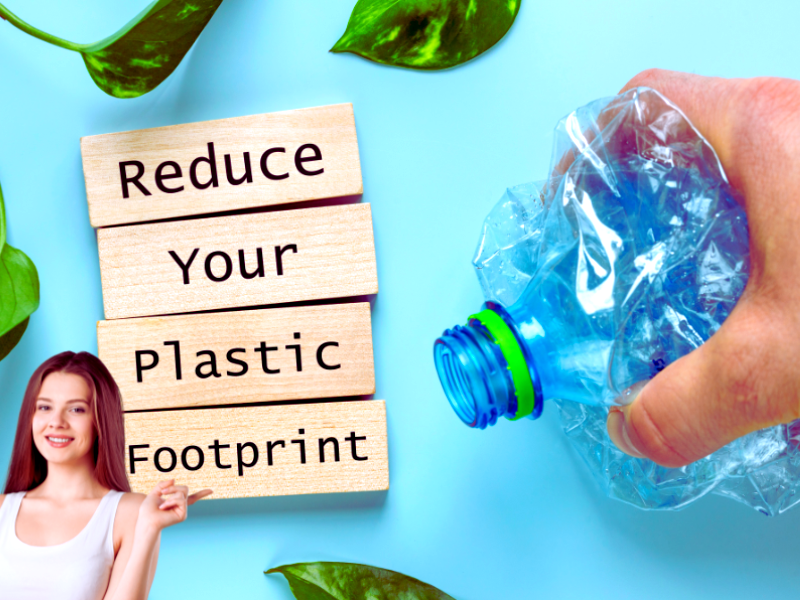
One of the main environmental benefits of reverse osmosis systems is their ability to reduce the need for bottled water. By providing a reliable source of clean drinking water at home, RO systems help to decrease the consumption of plastic water bottles, which can have a significant environmental impact.
Additionally, reverse osmosis systems are generally more energy-efficient than other water purification methods, such as distillation. This makes them a more sustainable choice for households looking to reduce their environmental footprint.
Health Benefits of Reverse Osmosis Water
Drinking water purified by reverse osmosis water filter offers several health benefits. By removing contaminants such as volatile organic compounds, heavy metals, and dissolved salts, RO systems provide water that is safe and healthy to drink. This can help to reduce the risk of waterborne illnesses and improve overall health.
In addition to removing harmful contaminants, reverse osmosis water is also free from chlorine and other chemicals that can affect the taste and odor of water. This makes it more enjoyable to drink, encouraging better hydration and overall well-being.
Reverse Osmosis and Mineral Content
One common concern with reverse osmosis water is that it removes not only harmful contaminants but also beneficial minerals. While it's true that RO systems can remove minerals such as calcium and magnesium, the impact on overall health is generally minimal.
Most people obtain the majority of their essential minerals from food rather than water. Additionally, some reverse osmosis systems include remineralization filters that add beneficial minerals back into the water, ensuring that you still receive the nutrients you need.
Reverse Osmosis and Water Softening
Reverse osmosis systems can also help to soften water by removing hardness-causing minerals such as calcium and magnesium. This can be particularly beneficial in areas with hard water, as it helps to prevent scale buildup in pipes and appliances.
While reverse osmosis is not a replacement for a dedicated water softener, it can provide some of the same benefits, making it a versatile solution for improving water quality.
Reverse Osmosis for Brackish Water
Reverse osmosis is an effective method for treating brackish water, which contains higher levels of dissolved salts than freshwater but lower levels than seawater. By removing these dissolved salts, RO systems can provide clean, fresh water from brackish sources.
This makes reverse osmosis a valuable tool for areas with limited access to fresh water, as it allows for the treatment of alternative water sources. The ability to treat brackish water also makes RO systems useful for agricultural and industrial applications.
Reverse Osmosis for Contaminated Water

In addition to treating brackish water, reverse osmosis is also highly effective at purifying contaminated water. This includes water contaminated with volatile organic compounds, heavy metals, and other harmful substances. By removing these contaminants, RO systems provide safe and clean drinking water.
This makes reverse osmosis a valuable solution for areas with contaminated water supplies, as well as for emergencies where access to clean water is limited. The ability to provide reliable, high-quality water makes RO systems an important tool for ensuring public health and safety.
Reverse Osmosis for Industrial Applications
Reverse osmosis is not only used for residential water filtration but also has a wide range of industrial applications. This includes the treatment of process water, wastewater, and boiler feedwater. By removing contaminants, RO systems help to improve the efficiency and longevity of industrial equipment.
In addition to improving water quality, reverse osmosis can also help to reduce the environmental impact of industrial processes by minimizing the discharge of harmful contaminants. This makes RO systems a valuable tool for industries seeking to improve sustainability and compliance with environmental regulations.
Reverse Osmosis for Agricultural Applications
Agriculture is another area where reverse osmosis can play a crucial role. By providing clean, filtered water, RO systems help to improve crop yields and reduce the risk of contamination from harmful substances. This is particularly important for crops that are sensitive to water quality, such as hydroponic systems.
In addition to improving crop quality, reverse osmosis can also help to reduce the environmental impact of agricultural practices by minimizing the use of chemical fertilizers and pesticides. This makes RO systems a valuable tool for sustainable agriculture.
Summary
Reverse osmosis (RO) water filters are an excellent way to ensure you have clean, pure drinking water. They work by forcing water through a special membrane that removes harmful contaminants like heavy metals, chemicals, and dissolved salts. This process makes the water safer and better tasting. RO systems come in different types, including ones for single taps and whole-house setups. They're versatile and can be used for various purposes, from household drinking water to industrial and agricultural applications. Regular maintenance is key to keeping your RO system in top shape. To keep up with the latest water filter tips and offers, subscribe to our newsletter today!
FAQs
What contaminants does reverse osmosis remove?
Reverse osmosis removes many harmful substances from water, including volatile organic compounds (VOCs), heavy metals like lead and mercury, and dissolved salts. It also helps eliminate chlorine and other chemicals that might affect the taste and smell of your water.
How often should I replace the filters in my RO system?
You should replace the filters in your RO system regularly to keep it working well. Sediment and activated carbon filters usually must be replaced every 6-12 months. Depending on your water quality and usage, the RO membrane might need changing every 2-3 years.
Can I use reverse osmosis water filters for my pets?
Yes, reverse osmosis filters are great for pets. It’s clean and free from contaminants, which helps keep them healthy and hydrated. This is especially important for pets with sensitive digestive systems or those prone to waterborne illnesses.
